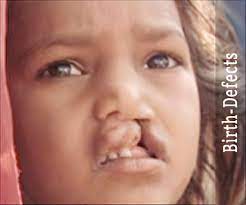Birth defects occur in approximately 3% of all live births, which means that every year, more than 250,000 babies are born with a birth defect. A birth defect is a problem that occurs at the time of birth. Birth defects can affect how your body looks or how it works. Birth defects are sometimes called congenital conditions. Birth defects affect every child differently, but they may cause problems in physical health, mental health, development, or behavior. Birth defects can affect body structures (such as limbs, heart, and brain), function (such as breathing or digestion), or both. They can be structural abnormalities (such as cleft lip) or functional abnormalities (such as Down syndrome).
Types of birth defects
They can occur at any point during fetal development, but some may not become apparent until after childbirth. The most common types of birth defects include neural tube defects, congenital heart defects and cleft palate.
Neural tube defects (NTDs) are a group of serious birth defects that occur in the brain and spinal cord. Anencephaly, spina bifida, and encephalocele are examples of NTDs. Babies with NTDs have more than four times the risk of dying compared to babies without these conditions.
Congenital heart defects (CHDs) are a leading cause of death in children under one-year-old and the most common structural birth defect. While the number of babies born with congenital heart defects is relatively small, they make up an important part of any pediatric cardiologist’s practice. These patients require specialized care from the time of birth through adolescence and into adulthood.
A Cleft palate is a common birth defect that occurs when the tissues at the roof of the mouth (palate) don’t fuse together correctly. It’s usually present at birth and can vary in severity from a small notch to a complete split in the palate. The most common form of cleft palate, called unilateral (or incomplete) cleft lip and palate, isn’t usually noticeable at birth. However, it may cause speech problems or affect your child’s facial appearance as your child grows older.
What causes birth defects?
Birth defects of the brain and spinal cord are a major cause of death and disability among children. Birth defects that affect the brain and spinal cord can include structural malformations, such as spina bifida, anencephaly, hydrocephaly, or microcephaly, and disorders of neural tube development. In addition to these birth defects caused by abnormal development during the first 28 days after conception, there are also genetic conditions that can result in birth defects affecting brain function. The causes of birth defects are wide-ranging. They can be attributed to environmental, occupational, genetic factors or a combination of them. Birth defects can be caused by many factors, including genetics, medicines, infections, radiation, or environmental toxins.
Genetic birth defects
A genetic disorder is a condition caused by an abnormality in the DNA sequence of the genome. A person with a genetic disorder has an abnormal gene or genes, passed on from parent to child, that causes the disorder. In many cases, these can be prevented if the responsible gene is identified early enough. Genetic screening for birth defects is widely available today and recommended for people who have a family history of genetic birth defects or have previously had a child born with a genetic defect.
Environmental birth defects
Environmental pollution has been linked to a high rate of birth defects in some countries. A study by the American Academy of Pediatrics found that children whose mothers lived within 10 kilometres (about 6 miles) of a freeway or major road were more likely to have physical and mental problems than other children. Environmental exposure may also play a role in some types of cancer, asthma, and type 2 diabetes. Environmental birth defects are conditions caused by exposure to environmental agents or factors during critical periods of development before birth. These include congenital heart disease, neural tube defects, cleft lip and palate, musculoskeletal disorders, oral clefts and clubfoot.
Genetic and Environmental Birth Defects
Genetic and environmental birth defects are serious public health issues. Birth defects occur when a baby is born with a defect caused by abnormal development of some part of the body. Birth defects range from minor problems to severe disabilities that may cause lifelong problems. The effects vary from mild to severe, depending on the type and severity of the defect. We all know that birth defects are caused by a combination of both genetic and environmental factors. Studies have shown that if the mother smokes while pregnant, there is an increased risk of the child being born with a cleft palate. Some studies also suggest that this may be due to chemical reactions in the mother’s body while exposed to nicotine, which can cause changes in chromosomes or genes, resulting in physical defects.
Who is at risk of having a child with a birth defect?
Anybody who is pregnant or could be at risk of pregnancy can have a baby with a birth defect. Pregnant women are at higher risk for having babies with birth defects, but men can also carry genetic mutations that cause birth defects. Birth defects are the most common type of disability in children, and they affect about 3% of all live births. It has long been known that women who smoke, drink alcohol, or use certain medications during pregnancy are at risk of having a child with birth defects. Now, new research is shedding light on what can be done to reduce the risk of birth defects.
Congenital birth defects
Congenital birth defects are those conditions that are present at birth. In some cases, they can be corrected by surgery or other treatment. However, many of these defects cannot be fixed and may need to be handled with care for a lifetime. Congenital defects occur in approximately 1 out of every 33 births. That means that there are over 4 million people in America who have a congenital defect. Congenital birth defects (CBD) are a broad category of conditions present at birth that affect the health and wellbeing of infants and children. Some common congenital disorders include cleft lip and cleft palate, clubfoot, cystic fibrosis, and Down syndrome. While these conditions cannot be cured once an infant is born from a mother who carries the condition or defect in her genes, there are many treatments available to help ease symptoms.
What are the most common birth defects?
The most common birth defects include cleft palate (where the lip or roof of the mouth does not form correctly), clubfoot (when one or both feet curve inward instead of pointing straight ahead), and Down syndrome (when there is an extra chromosome in each cell). Birth defects can be genetic or non-genetic. It is completely unrelated to one’s family genetics. However, it can be caused by chromosomal issues that are hereditary. The most common birth defects by percentage. Cleft lip and palate affect approximately 1 in 700 newborns; Spina bifida affects approximately 1 in 2,000 newborns, and Polydactyly affects approximately 1 in 3,600 newborns. This is a list of the most common birth defects as measured by their prevalence per 10,000 births of the world population. The figures are from the Centers for Disease Control in the United States.
How can we prevent birth defects?
There are many causes of birth defects. To prevent these defects from occurring, it is important to understand the causes and take precautions before conceiving a child. Birth defects are extremely hard to prevent. It can be caused by several different things, such as the mother’s health, environmental toxins, and even genetics. Birth defects can occur at any time during pregnancy or shortly after birth, but it usually happens during the first three months after conception. Early detection is vital for treatment options with proven success rates.
Final thoughts
It is important to know that birth defects are not inherited. They occur during pregnancy due to a combination of genetic and environmental factors. The most common birth defects include heart defects, cleft lip and palate, and club foot. Birth defects can be detected before birth through fetal ultrasound screening or genetic testing. Treatment for a birth defect may involve surgery, medications, assistive devices such as braces, physical therapy, and more. It is important to know the risk factors for pregnancy complications that can lead to birth defects and to talk with your doctor about ways to reduce your risk of certain conditions.








